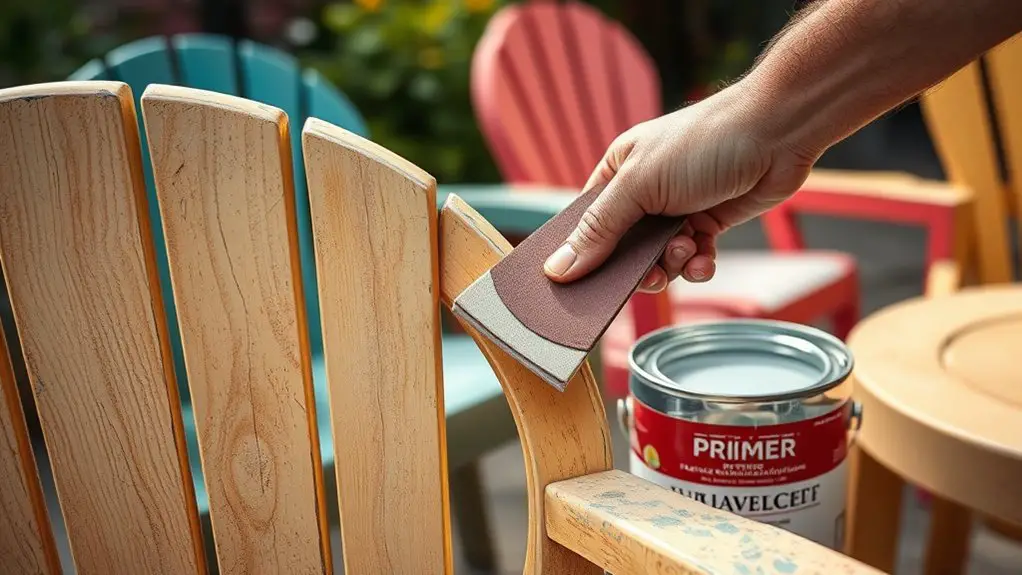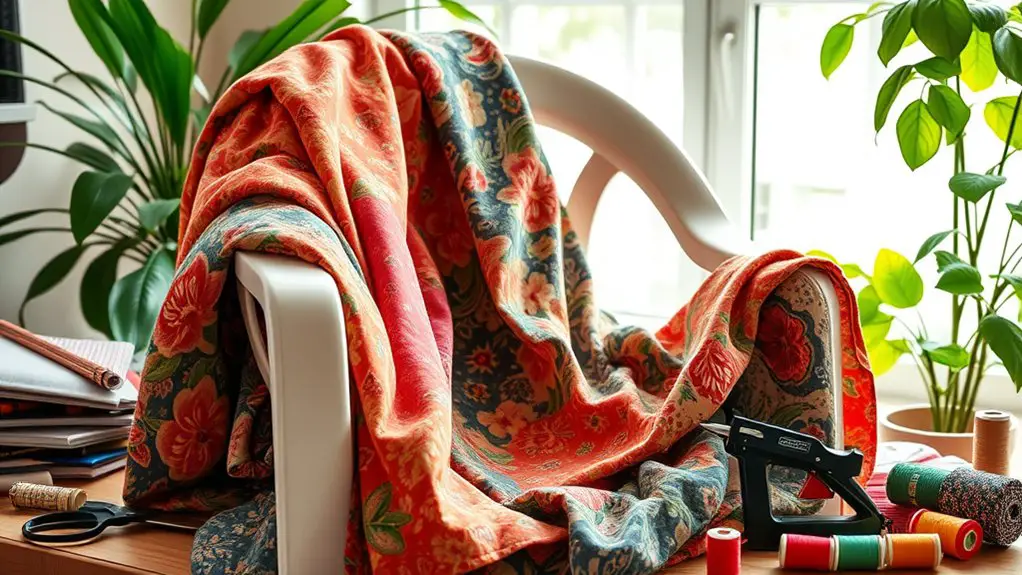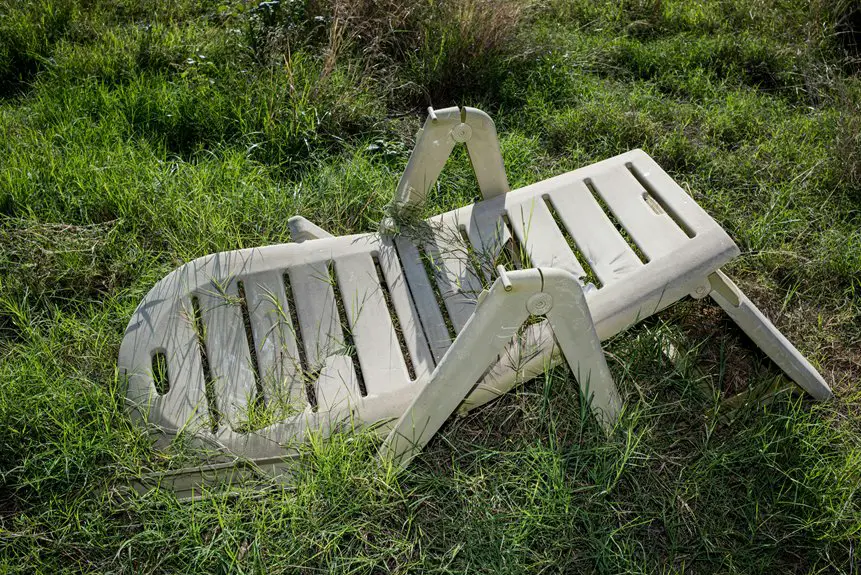Upcycling plastic furniture is a creative way to refresh your home while being eco-friendly. Start by thoroughly cleaning the pieces; identify the type of plastic and use a mild detergent for scrubbing. Next, check for any damage and make necessary repairs with appropriate adhesives. Once you've prepared the surface, you can paint it using a primer designed for plastics, followed by spray paint and a clear coat for durability. If upholstery is needed, remove the old fabric and replace it with something new and stylish. With these steps, you're on your way to stunning furniture transformation. Keep going to discover advanced tips!
Key Takeaways
- Clean the plastic furniture thoroughly using mild detergent and a soft brush to remove dirt and debris before upcycling.
- Inspect for any damage, repairing cracks or breaks with appropriate adhesives or fillers to ensure structural integrity.
- Prepare the surface by lightly sanding it and applying a plastic-specific primer to enhance paint adhesion for a fresh look.
- Choose high-quality spray paint designed for plastic, applying multiple thin coats and sealing with a clear coat for durability.
- Consider reupholstering with new fabric or adding protective coverings to refresh the furniture while increasing its longevity.
Preparation and Cleaning
Before diving into your DIY upcycling project, it's crucial to properly prepare and clean your plastic furniture. Start by identifying the type of plastic, as this helps determine the best cleaning methods. Remove any loose debris or dirt from the surface first.
Next, mix a mild detergent with water and use it to clean the plastic, steering clear of harsh chemicals. A soft-bristled brush is perfect for scrubbing away stubborn grime. Rinse thoroughly and allow the surface to dry completely. When choosing a cleaning solution, consider the Environmental Impact of the chemicals you use.
For areas with heavy staining, use a more concentrated cleaner. Wipe down intricate parts with a soft cloth, ensuring you avoid abrasive materials that could scratch the surface. If you encounter stubborn stains, let the cleaner sit for a few minutes before wiping it clean.
After you've ensured all areas are free of residue, it's time to tackle any old finishes. Use a suitable solvent or paint stripper as per the manufacturer's instructions, and carefully scrape off the old finish with a plastic scraper. It's also beneficial to utilize paint to cover any imperfections on the surface. Clean the surface again to remove any residue, ensuring it's completely dry before moving on to the next steps.
Assessing and Repairing
Once your plastic furniture is clean and ready for its new life, it's time to assess its condition. Start by identifying the type of plastic used, as this will help you determine the best upcycling methods.
Check for any damage such as cracks, breaks, or wear and tear. Evaluate the structural integrity to ensure it can withstand any new use. Don't forget to inspect for contaminants or residues that need removal.
If you find structural damage, use appropriate adhesives or glues suited for the plastic type. You might also consider mechanical methods like welding or bolting to reinforce weak points.
For any broken parts, replace them with similar materials or compatible alternatives. Fill gaps or cracks with plastic fillers or epoxies, and reinforce joints and seams for added durability.
Finally, take a close look at the color and texture of your furniture. This assessment will guide you in making decisions about aesthetic enhancements that will breathe new life into your piece. In this process, consider that upcycling promotes creative reuse which can lead to unique and personalized designs.
With a thorough evaluation and necessary repairs, you can confidently move forward with your upcycling project!
Surface Preparation for Painting

Preparing the surface of your plastic furniture is crucial for achieving a smooth and durable finish when painting. Start by cleaning the entire surface thoroughly. For older pieces with mildew or mold, use a strong cleaning agent like vinegar or bleach. Newer furniture can be cleaned with an all-purpose cleaner, such as dish soap. Rinse it well, preferably with a pressure hose, and allow it to dry completely.
Next, lightly sand the plastic surface using fine grit sandpaper (180 to 220 grit). This step helps improve paint adhesion, especially if the surface is very smooth or has faded. If old paint is flaking off, it's essential to sand it down. Additionally, using a plastic-specific primer will further enhance the bond between the paint and the surface.
After sanding, remove dust and debris with a dry cloth, then follow up with a wet rag using mineral spirits or isopropyl alcohol to trap any remaining particles.
Finally, wipe the surface with water and let it dry well. To ensure the best paint adhesion, apply a plastic-specific primer in even, light coats, allowing it to dry fully according to the instructions. Proper surface preparation sets the stage for a successful painting project!
Painting and Decorating
When it's time to transform your plastic furniture, choosing the right paint is essential for achieving a stunning, long-lasting finish. Start by selecting a spray paint designed specifically for plastic, like Rust-Oleum 2X Ultra Cover Paint+Prime. This ensures compatibility with the material.
Here are three key steps to follow:
- Priming and Coating: Apply a plastic primer first, such as Dulux 325g Duramax. Then, use a clear coat sealer to enhance durability. Opt for multiple thin coats rather than a single thick layer, allowing each coat to dry completely before adding the next. This process will enhance the aesthetics and durability of your furniture.
- Color and Finish: Explore various colors and finishes, like Rust-Oleum Chalked for a matte look or satin for a subtle sheen. Test your chosen colors on a small, hidden area to see how they work with your decor.
- Post-Painting Care: Once painted, avoid moving the furniture until it's fully dried and hardened. Protect the surface from direct sunlight, and regularly check for wear to keep it looking fresh.
With these tips, your upcycled plastic furniture will look fabulous!
Reupholstering and Covering

After giving your plastic furniture a fresh coat of paint, reupholstering adds an extra layer of style and comfort.
Start by flipping the furniture over to access the underside, where you'll find staples holding the old fabric. Use a flat-head screwdriver and pliers to remove these staples carefully. As you do this, note how the old fabric was attached—it'll guide you in the new upholstery process. Inspect the underlying structure for any damage that needs repair.
Next, prepare your new upholstery. Cut the new fabric slightly larger than the area to be covered and lay it over the piece, securing it with pins if needed. If the old padding is worn out, use foam or batting to enhance comfort. Mark the positions of any buttons or tufts on the new fabric's backside.
To attach the new upholstery, use a staple gun, starting from the center and working outward. For tufted designs, thread strings through marked holes to create the tufts. Incorporating upcycling practices not only enhances the aesthetic but also contributes to a more sustainable lifestyle.
Finally, trim any excess fabric and consider adding protective coverings like plastic or vinyl for durability and easy cleaning.
Frequently Asked Questions
Can I Upcycle Plastic Furniture Outdoors?
Yes, you can upcycle plastic furniture outdoors! Just clean it thoroughly, choose durable materials, and get creative with colors and designs. Use proper tools and safety gear to ensure a successful and enjoyable project.
What Types of Paint Are Best for Outdoor Plastic Furniture?
For outdoor plastic furniture, use specialist plastic spray paints for easy application and durability. You could also opt for epoxy-based paint for a tough finish, but ensure proper surface preparation for best results.
How Long Does the Upcycling Process Typically Take?
The upcycling process typically takes anywhere from a few hours to several days. It depends on collection, sorting, cleaning, transformation, and assembly stages, along with the complexity of your project and your skill level.
Is It Safe to Use Heat Tools on Plastic Furniture?
Using heat tools on plastic furniture can be risky. You should know the plastic type's temp tolerance, ensure proper ventilation, wear protective gear, and keep the area clear of flammable materials to stay safe.
Can I Upcycle Plastic Furniture Without Painting It?
Yes, you can upcycle plastic furniture without painting it. Focus on thorough cleaning, minor repairs, and using protective coatings to enhance the original look. Often, restoring the surface is enough to refresh its appearance.

